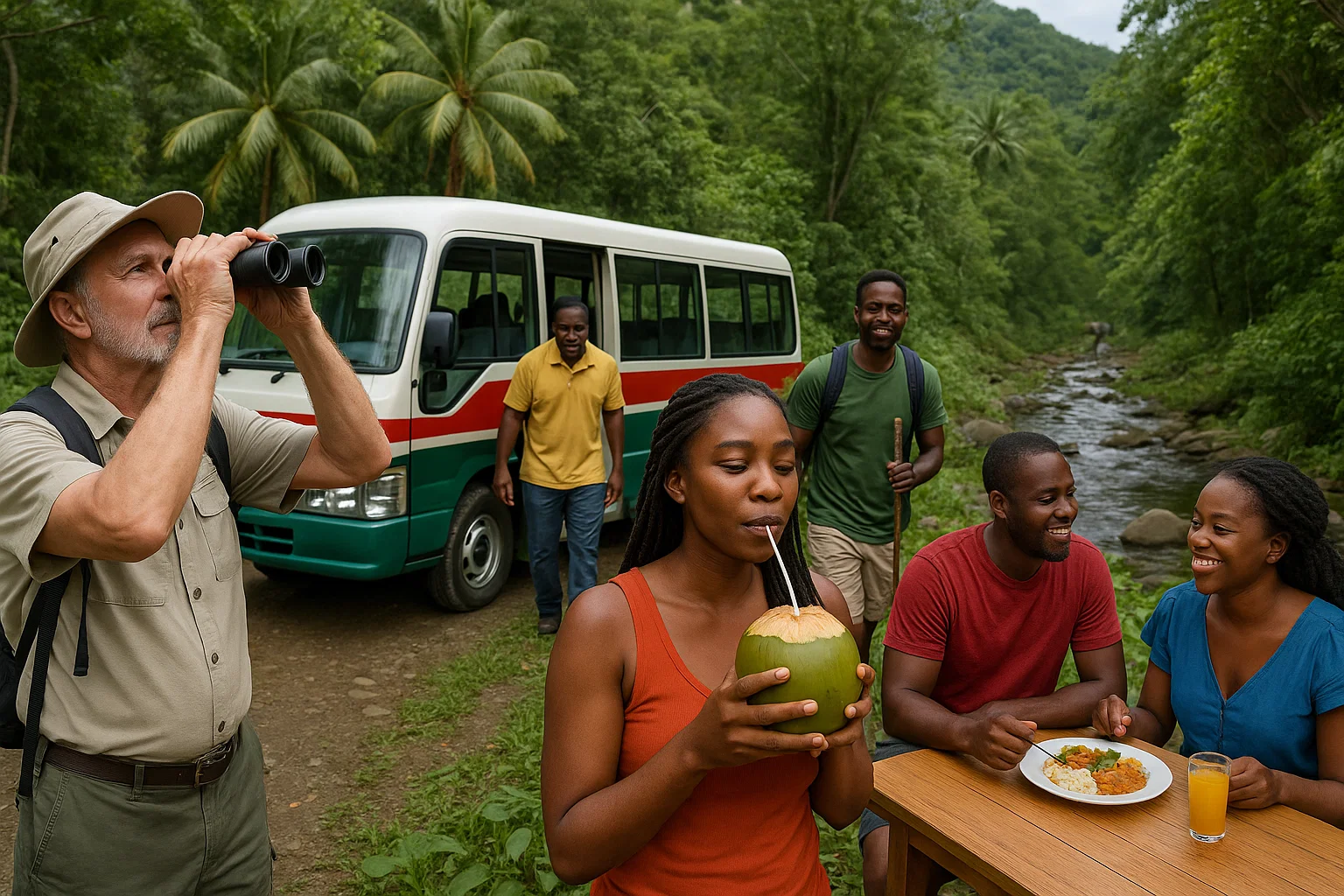Vacationing in Dominica

Vacationing in Dominica begins with a certain quietness that visitors often notice right away. Morning light comes slowly over the hills, river sounds carry into nearby rural communities, and the island feels less hurried than many other Caribbean destinations. People travel here for nature, but the experience is also shaped by small details: a conversation with a guide, an unexpected visit to a river pool, or the taste of a Creole lunch shared at a roadside spot. The island rewards visitors who enjoy natural scenery and who appreciate the sense of community that defines daily life. Planning a stay involves understanding both the landscape and the practical services that support it.
Planning Costs, Building a Base and Getting Settled
Dominica’s accommodation options range across several budget levels. Guesthouses and small apartments usually cost between US$60 and US$100 per night. Mid-range hotels and eco-lodges tend to sit between US$120 and US$190. Higher-end properties, such as boutique resorts, villas and spa-focused accommodations, often range from US$250 to US$450 or more during peak seasons. Roseau offers convenient city-style stays, Portsmouth provides coastal retreats with access to historic and natural attractions, and areas like Soufrière, Calibishie, Laudat and Wotten Waven are better suited for travellers interested in wellness, nature or quiet surroundings.
Food costs depend largely on how often visitors eat out, with a basic Creole lunch ranging from EC$20 to EC$40 (US$7–US$15) and dinner for two at a mid-range restaurant reaching about EC$150 (US$55). Cooking at home lowers expenses, especially when combined with purchases from fresh markets in Roseau or Portsmouth. Supermarkets such as Astaphans and Whitchurch IGA carry imported and local products, while minimarts and community shops provide day-to-day necessities. Fresh produce, herbs, and seasonal items are easiest to find at the main markets, particularly on busy Friday and Saturday mornings.
Visitors staying longer often purchase prepaid SIM cards from FLOW or Digicel. Both telecoms companies provide reliable coverage across most of the island, and data top-ups can be made through mobile apps or local retail outlets. Many accommodations offer Wi-Fi, though speeds can vary by location and weather conditions.
Transport planning matters because a private taxi from Douglas Charles Airport (DOM) to Roseau typically costs EC$200 to EC$230, about US$75 to US$85, while short town trips run EC$15 to EC$20. Longer village routes can reach EC$80 or more based on distance and passengers, and minibuses cover many areas at lower prices, though schedules remain flexible for most travellers across the island each day as well. Rental cars remain available for visitors who prefer independence, but the island’s narrow mountain roads require careful driving. Some travellers mix taxis and buses to balance convenience and cost.
A practical daily budget often falls into one of the following ranges:
- US$80 to US$120 for budget travellers who stay in guesthouses, use buses and rely primarily on local food.
- US$140 to US$220 for mid-range visitors who combine small hotels, restaurant meals and organised tours.
- US$250 or more for higher-end stays that include private transport and frequent excursions.
Dominica’s accommodation landscape includes familiar names such as Fort Young Hotel, La Flamboyant Hotel, Secret Bay, InterContinental Dominica Cabrits Resort & Spa, Hotel The Champs, Picard Beach Cottages, Jungle Bay, The Anchorage Hub and several scenic lodges in the northeast, Salisbury and Portsmouth. Each option offers its own style, whether focused on diving, wellness, adventure or relaxation.
Rivers, Lakes, Trails and Marine Encounters
Freshwater activities form a key part of vacationing in Dominica. Rivers such as the Layou River, Roseau River, Hampstead River and Pagua River offer both relaxation and activity. Many visitors bathe in river pools after hikes or join river tubing safaris along the Layou Valley, which offers gentle flows and short rapids, creating a fun yet approachable experience. Kayaking is available in several areas where currents remain safe and views of forested riverbanks add to the journey.
Lakes provide a different atmosphere. Freshwater Lake sits high in the hills with cooler air and sweeping views, and the Freshwater Lake trail, which loops, allows visitors to circle the water. Boeri Lake offers a slightly more challenging hike but rewards visitors with a quiet, high-altitude setting. Waterfalls are among the island’s most visited attractions with Trafalgar Falls and Emerald Pool are suitable for visitors who prefer short walks, while Middleham Falls and Victoria Falls require more effort. The hike to Boiling Lake is challenging and usually completed with experienced guides who understand the route and the changing weather patterns.
Admission fees for natural sites remain modest. Guided hikes often begin around US$40 to US$60 for half-day outings. More technical canyoning routes or full-day mountain hikes cost more due to safety and equipment demands. Multi-site passes are available through the forestry and national parks systems and are helpful for visitors planning several excursions.
Along the coast, Dominica’s volcanic origins shape dramatic cliffs and rocky beaches, but there are also quiet bays suitable for swimming. The southwest corner of the island, particularly Soufrière and Scotts Head, is well known for snorkelling and scuba diving with Champagne Reef, named for its warm volcanic bubbles, is a favourite among snorkellers. Dangleben’s Pinnacles and the Scotts Head Drop-off attract divers who enjoy varied marine ecosystems. Two-tank scuba trips usually cost between US$80 and US$130, while snorkelling excursions are less expensive and often include gear.
Whale watching is one of Dominica’s most recognised activities. Sperm whales live in the deep trench off the west coast, and sightings are common throughout the year. Operators such as Dive Dominica, Cabrits Dive Centre and Island Discovery Tours guide excursions that last three to four hours and cost between US$60 and US$100, where dolphins often appear and calm seas frequently provide excellent viewing conditions for visitors.
Visitors who enjoy outdoor activity often build their time around a combination of the following experiences:
- River bathing, tubing and short river walks
- Hiking to lakes and waterfalls in the central highlands
- Day segments of the Waitukubuli National Trail
- Whale watching along the west coast
- Diving or snorkelling in Soufrière and Scotts Head
- Kayaking or coastal boat rides in sheltered bays
This variety allows different levels of fitness and interest to blend into a single itinerary.
Culture, Food, Markets and Local Rhythms
Dominica’s culture adds richness to visits through everyday moments, and the Kalinago Territory deepens cultural experiences with craft demonstrations, cassava bread making and explanations of Indigenous traditions that continue to shape community life. The atmosphere feels older and more rooted in tradition, and guided tours help visitors understand why the territory remains so crucial to national identity.
Roseau’s narrow streets, corner shops, bakeries and bustling riverfront shape everyday life, complemented by the Dominica Museum’s brief but informative presentation of the island’s history. Portsmouth has a calmer feel, with its own market, university presence and access to Cabrits National Park. Smaller communities on the west and east coasts reveal different rhythms, from church gatherings to fishing days.
Food plays a central role in Dominican life and in the visitor experience. Local restaurants serve dishes built around plantain, dasheen, yam, green banana, breadfruit and fish or chicken. Outdoor grills appear on weekends, especially in coastal villages. Seafood in Soufrière, Scotts Head, Portsmouth, and Calibishie pairs easily with fresh juice bars, bakeries and small cafés for quick meals, while supermarkets and local markets give visitors the option to prepare dishes with island ingredients during longer stays.
Bouyon, calypso, reggae and gospel echo through communities and add depth to cultural life, and the World Creole Music Festival brings even greater energy during the Independence season. Even without significant events, visitors encounter music in everyday spaces, from church choirs to street gatherings.
Suggested Areas and Practical Styles of Stay
Dominica’s geography encourages travellers to stay in more than one area if time allows. Visitors seeking food options, supermarkets, dive shops and cultural sites tend to choose Roseau, whereas Portsmouth appeals more to those who prefer beaches, Cabrits National Park and the broader northern coastline. Soufrière and Scotts Head attract divers, snorkellers and those seeking hot springs and calm coastal evenings, while Calibishie and the Pagua region offer dramatic scenery, cooler breezes and quieter surroundings.
A range of tour operators support safe exploration, from hiking guides covering forest and mountain routes to marine teams running dives, snorkelling outings and whale-watching, and canyoning companies navigating volcanic gorges. Local taxi drivers often act as informal guides, recommending river spots, food stands or scenic detours.
Dominica leaves an imprint through its quiet routines and natural ease. You wake to birds in the hills, explore a trail that opens into a valley of ferns and steam, drift into a river pool as the afternoon settles, then sit down to a Creole plate that tastes richer after a day outdoors. Conversations with guides, farmers, shopkeepers, and hikers weave into your memory as naturally as the islandscape itself. The longer you stay, the more you notice how Dominica’s pace encourages you to breathe, walk slowly, look closer, and meet people in a way that feels genuine. Visitors often find that it is not a single waterfall or hike they miss the most, but the easy belonging the island offers without trying.




